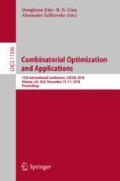Abstract
Network reliability is the probability that a network system can perform a desired operation, such as communication between facilities, against stochastic equipment failures. On analyzing network systems that are represented by undirected graphs, the all-terminal reliability (ATR) is commonly used as one of the network reliability. As a natural extension of the ATR for the directed version, the strongly connected reliability (SCR) is known. The SCR should be computed on various network systems, such as ad-hoc network, that demand the property called strongly connected. Unfortunately, computing the SCR is known to be #P-complete, and little studies challenge the computation of the exact or an approximate SCR on limited graph classes. In this study, we propose the first practically efficient algorithm to compute the exact SCR in general. The algorithm constructs a binary decision diagram (BDD) representing all the strongly connected spanning subgraphs (SCSSs) in a given directed graph. Subsequently, the algorithm computes the exact SCR by a dynamic programming on the BDD. To efficiently construct BDDs, we designed a new variant of the frontier based search (FBS). We conducted computational experiments to evaluate the proposed algorithm. The results demonstrated that the proposed algorithm succeeded in computing the SCR in real-world networks with a few hundred edges within a reasonable time, which was previously impossible.
Access this chapter
Tax calculation will be finalised at checkout
Purchases are for personal use only
Notes
- 1.
To avoid the confusion, we use the terms “vertex” and“edge” for a vertex and edge in the graph G, and “node” and“arc” for a vertex and edge in the BDD \(\mathcal {B}\). Vertices and nodes are denoted using Roman letters (\(u,v,\ldots \)) and Greek letters (\(\alpha ,\beta ,\ldots \)), respectively.
References
Won, J.M., Karray, F.: Cumulative update of all-terminal reliability for faster feasibility decision. IEEE Trans. Reliab. 59(3), 551–562 (2010)
Park, J.H.: All-terminal reliability analysis of wireless networks of redundant radio modules. IEEE Internet Things J. 3(2), 219–230 (2016)
Brown, J., Li, X.: The strongly connected reliability of complete digraphs. Netw.: Int. J. 45, 165–168 (2005)
Valiant, L.G.: The complexity of enumeration and reliability problems. SIAM J. Comput. 8, 410–421 (1979)
Karger, D.R.: A randomized fully polynomial time approximation scheme for the all terminal network reliability problem. In: Proceedings of the Twenty-seventh Annual ACM Symposium on Theory of Computing, STOC 1995, pp. 11–17. ACM, New York (1995)
Imai, H., Sekine, K., Imai, K.: Computational investigations of all-terminal network reliability via BDDs. IEICE Trans. Fundam. Electron. Commun. Comput. Sci. 82, 714–721 (1999)
Hwang, F.K., Wright, P.E., Hu, X.: Exact reliabilities of most reliable double-loop networks. Networks 30, 81–90 (1997)
Bryant, R.E.: Graph-based algorithms for boolean function manipulation. IEEE Trans. Comput. 35(8), 677–691 (1986)
Frederickson, G.N., JáJá, J.: Approximation algorithms for several graph augmentation problems. SIAM J. Comput. 10(2), 270–283 (1981)
Vincent, D., Cecile, B.: Transitive reduction for social network analysis and visualization. In: Proceedings of the 2005 IEEE/WIC/ACM International Conference on Web Intelligence, WI 2005, pp. 128–131. IEEE Computer Society, Washington, D.C. (2005)
Ardito, C.F., Paola, D.D., Gasparri, A.: Decentralized estimation of the minimum strongly connected subdigraph for robotic networks with limited field of view. In: 2012 IEEE 51st IEEE Conference on Decision and Control (CDC), pp. 5304–5309, December 2012
Albert, R., DasGupta, B., Dondi, R., Sema Kachalo, E.S., Zelikovsky, A., Westbrooks, K.: A novel method for signal transduction network inference from indirect experimental evidence. J. Comput. Biol. 14(7), 927–949 (2007)
Aditya, S., DasGupta, B., Karpinski, M.: Algorithmic perspectives of network transitive reduction problems and their applications to synthesis and analysis of biological networks. Biology 3(1), 1–21 (2014)
Kawahara, J., Inoue, T., Iwashita, H., Minato, S.: Frontier-based search for enumerating all constrained subgraphs with compressed representation. IEICE Trans. Fundam. E100-A(9), 1773–1784 (2017)
Kinnersley, N.G.: The vertex separation number of a graph equals its path-width. Inf. Process. Lett. 42(6), 345–350 (1992)
Inoue, Y., Minato, S.: Acceleration of ZDD construction for subgraph enumeration via path-width optimization. TCS-TR-A-16-80. Hokkaido University (2016)
Yoshinaka, R., Kawahara, J., Denzumi, S., Arimura, H., Minato, S.: Counterexamples to the long-standing conjecture on the complexity of BDD binary operations. Inf. Process. Lett. 112, 636–640 (2012)
Bergman, D., Ciré, A.A., van Hoeve, W., Hooker, J.N.: Decision Diagrams for Optimization. Artificial Intelligence: Foundations, Theory, and Algorithms. Springer, Cham (2016). https://doi.org/10.1007/978-3-319-42849-9
Maurer, P.: Generating strongly connected random graphs. In: Proceedings of the 2017 International Conference on Modeling, Simulation and Visualization Methods, MSV 2017, pp. 3–6. CSCE, Las Vegas (2017)
Boros, E., Elbassioni, K., Gurvich, V., Khachiyan, L.: Enumerating minimal dicuts and strongly connected subgraphs and related geometric problems. In: Bienstock, D., Nemhauser, G. (eds.) IPCO 2004. LNCS, vol. 3064, pp. 152–162. Springer, Heidelberg (2004). https://doi.org/10.1007/978-3-540-25960-2_12
Acknowledgement
This work was supported by JSPS KAKENHI Grant Number 15H05711.
Author information
Authors and Affiliations
Corresponding authors
Editor information
Editors and Affiliations
Rights and permissions
Copyright information
© 2018 Springer Nature Switzerland AG
About this paper
Cite this paper
Suzuki, H., Ishihata, M., Minato, Si. (2018). Exact Computation of Strongly Connected Reliability by Binary Decision Diagrams. In: Kim, D., Uma, R., Zelikovsky, A. (eds) Combinatorial Optimization and Applications. COCOA 2018. Lecture Notes in Computer Science(), vol 11346. Springer, Cham. https://doi.org/10.1007/978-3-030-04651-4_19
Download citation
DOI: https://doi.org/10.1007/978-3-030-04651-4_19
Published:
Publisher Name: Springer, Cham
Print ISBN: 978-3-030-04650-7
Online ISBN: 978-3-030-04651-4
eBook Packages: Computer ScienceComputer Science (R0)

